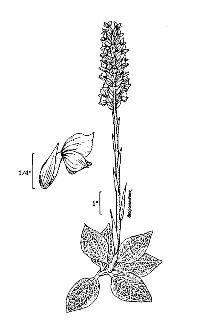Peramium pubescens (Willd.) MacMill.
Scientific Name: Peramium pubescens (Willd.) MacMill.

| General Information | |
|---|---|
| Usda Symbol | PEPU20 |
| Group | Monocot |
| Life Cycle | Perennial |
| Growth Habits | Forb/herb |
| Native Locations | PEPU20 |
Plant Guide
Use a soil moisture meter to monitor the soil moisture where Peramium pubescens (Willd.) MacMill. is planted.
Fact Sheet
Alternate Names
Peramium pubescens (Willd.)
Uses
Downy rattlesnake plantain is useful for woodland wildflower plantings and as an indoor terrarium plant. Medicinal Use: Native Americans used it to treat snakebites, burns and many other ailments.
Status
Downy rattlesnake plantain is listed as endangered in Florida and exploitably vulnerable in New York. Please consult the PLANTS Web site and your State Department of Natural Resources for this plant’s current status (e.g., threatened or endangered species, state noxious status, and wetland indicator values).
Description and Adaptation
Adaptation
Adaptation
Downy rattlesnake plantains are one of the many species of orchids native to eastern North America. They can be found growing in dry to moist upland woods with acidic soils. The plants are low growing with stems that creep along the soil surface, often dividing and forming small colonies. Leaves lay close to the soil in circular arrangement (basal rosette) around a central growing point. Leaves are oval and about 1.5 to 2.5 inches long. Downy rattlesnake plantain has striking leaves marked with a network of silvery veins and a broad stripe down the center, resembling the skin of a snake. All parts of the plant are covered with a very fine downy hair especially noticeable on the bloom spike. Despite the name, downy rattlesnake plantain is not related to the common lawn weed plantains, but has similar appearing rosettes of leaves. The evergreen foliage is attractive year round, with individual leaves lasting 3 to 4 years. It flowers in late summer with small white flowers densely packed on a slender cylindrical spike, 6 to 18 inches tall. Downy rattlesnake plantain occurs in the entire eastern half of the U.S. and Canada from Ontario and Quebec south to Oklahoma, Arkansas, Mississippi and Florida. Downy rattlesnake plantain distribution from USDA-NRCS PLANTS Database. For updated distribution, please consult the Plant Profile page for this species on the PLANTS Web site.
Establishment
Obtain only nursery/greenhouse propagated plants from reputable growers, and not wild collected plants. Orchids are slow to regenerate in the wild and may be easily eliminated through irresponsible wild collection, and may © Randy Pheobus be protected by law. Downy rattlesnake plantain requires a site with some shade and well-drained slightly acidic soil with sand and organic matter such as peat or leaf mold. The right soil conditions are important for survival. Acid soil and good drainage, especially in winter, are essential. Downy rattlesnake plantain is also one of the few native plants that can be easily grown indoors and it makes an excellent terrarium plant with its attractive leaves. Purchase only nursery grown plants from reputable nurseries.
Management
Downy rattlesnake plantain does well under the open shaded canopy of trees and taller shrubs. Smaller shrubs and low growing plants should not be allowed to grow very close or overtop of downy rattlesnake plantain.
Pests and Potential Problems
There are no known problems associated with downy rattlesnake plantain, Use soil moisture sensors to measure the soil moisture of Peramium pubescens (Willd.) MacMill..,
Environmental Concerns
There are no known environmental concerns associated with downy rattlesnake plantain. Cultivars, Improved, and Selected Materials (and area of origin) Downy rattlesnake plantain is available from commercial sources. There are currently no existing cultivars of downy rattlesnake plantain.
Prepared By
R. Jay Ugiansky; USDA, NRCS, Norman A. Berg National Plant Materials Center

